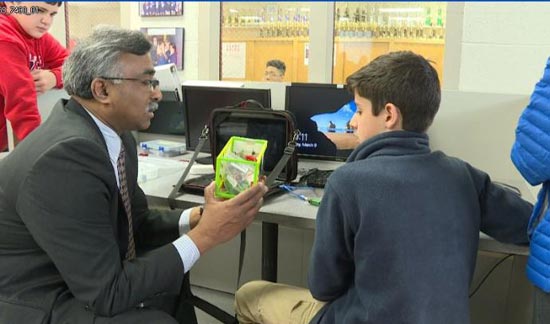Robertsville Middle students get $15,000 for NASA project

OAK RIDGE, Tenn. (WVLT) - Oak Ridge National Laboratory partners are backing a student-led CubeSat project with NASA with $15,000 in funds to develop the miniature satellite. ORNL Director Thomas Zacharia, PhD, visited STEM students at Robertsville Middle School on Friday, asking them to explain their project.
ORNL staff have been mentoring the students as they've gone through the process of applying for, and now being accepted by NASA, for sending their unique satellite up on a space mission.
Students at Robertsville Middle School in Oak Ridge received word previously from NASA on the acceptance of their proposal to launch a satellite into space. Todd Livesay's STEM class wants to use the satellite to monitor the regrowth of forests in Sevier County following the 2016 wildfires.
"This project is a big priority for us, and for our staff,"said Zacharia. He explained that ORNL wants to support education in the community, and he also finds this project particularly fascinating,
"this is a great project to be part of."
"We have worked pretty hard,"said eighth grade student Claire Thornton, whose father, Peter Thornton, PhD, is one of the ORNL scientists mentoring the students.
"This year was a lot of waiting. But last year, we did a lot of research."
Now that NASA has announced the Robertsville CubeSat is a high priority science payload, the school and its professional mentors are awaiting news about when their payload will be able to launch.
Peter Thornton, PhD said,
"And we'll know all the constraints about what our orbit will look like and that kind of thing. Once we have those details, we'll be able to design the mission and actually get it up into an orbit."
"It's like a prototype of what's gonna happen when the CubeSat actually gets deployed,"said eighth grader Maria Cacheiro about the plastic cubes she and her classmates have been creating in their classroom. They have access to multiple 3D printing devices for making the mini satellite devices.
The class turned in to NASA a lengthy proposal, with help from mentors at nearby Oak Ridge National Laboratory and Y-12, explaining how it would create a small satellite to accomplish its mission.
STEM teacher Livesay said before the school learned of NASA's decision,
"If we've been accepted into the program, we have two years to actually build the satellite and deliver it to NASA, then they will put it into space."
Once in orbit, the device would send back data to a ground station located at the school.
Some students in the science class said they have hopes of becoming scientists or engineers someday, perhaps even working for NASA. Others do not. Their instructor said he hopes they are all learning valuable life lessons.
"I hope that they're learning to not be afraid to try,"Livesay said.
"To just give it your best shot. To show up. And to try every day and make progress."
Here is NASA's announcement.
You can find the earlier NASA report on Robertsville Middle on the NASA website.

